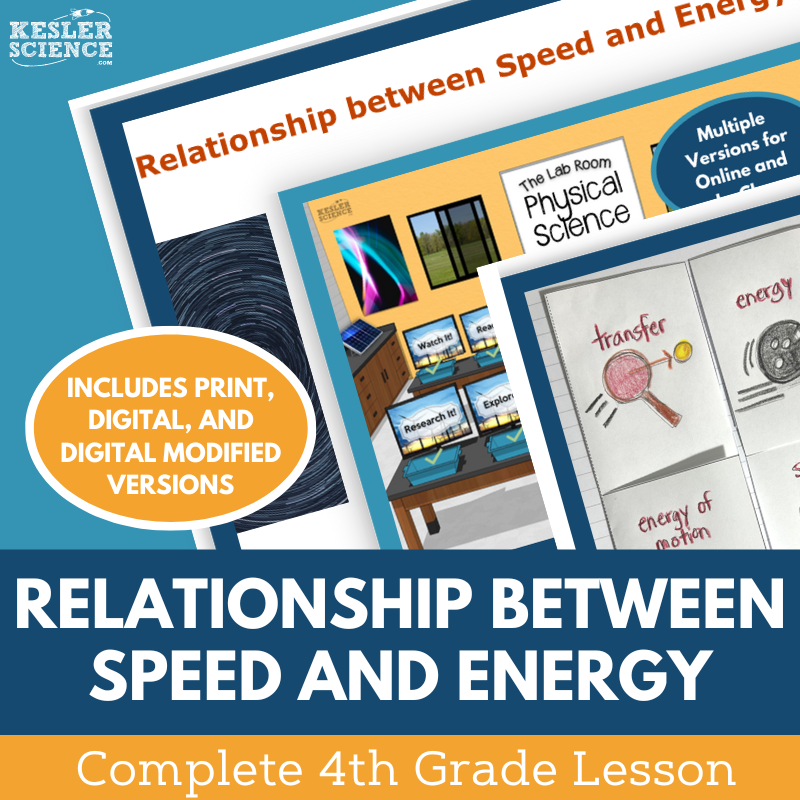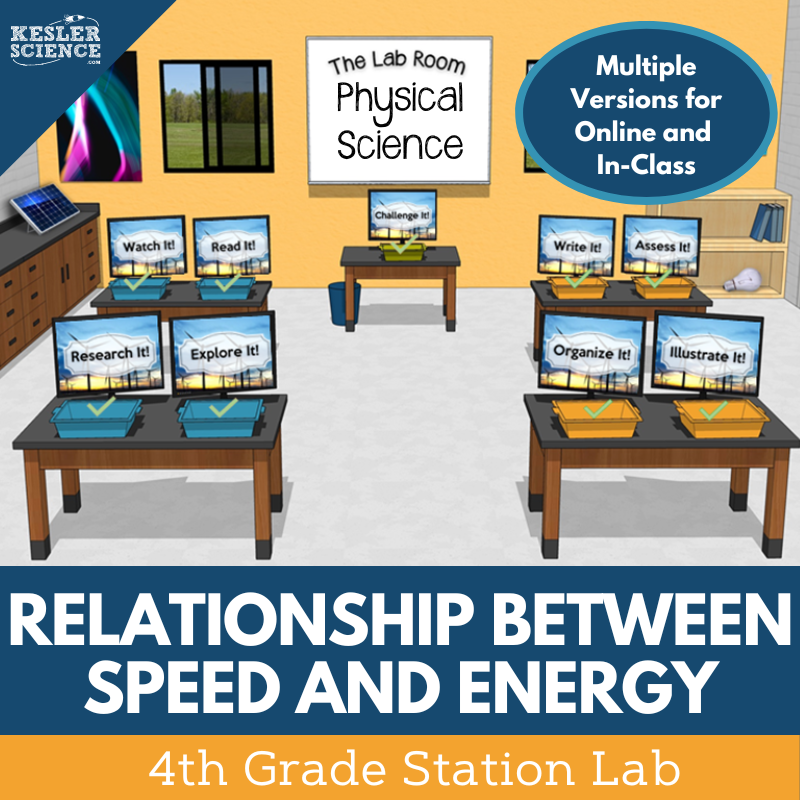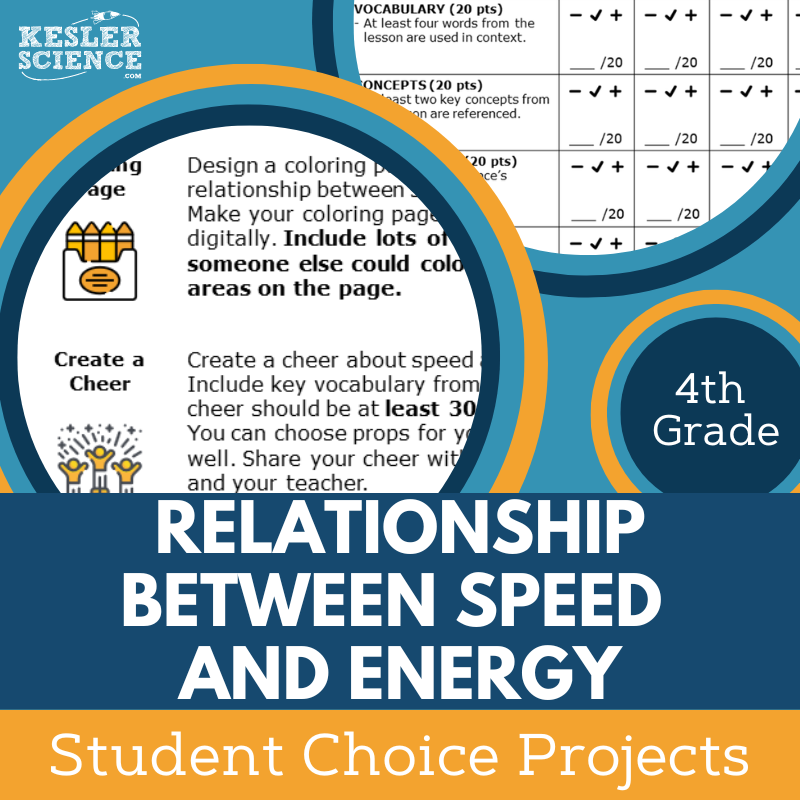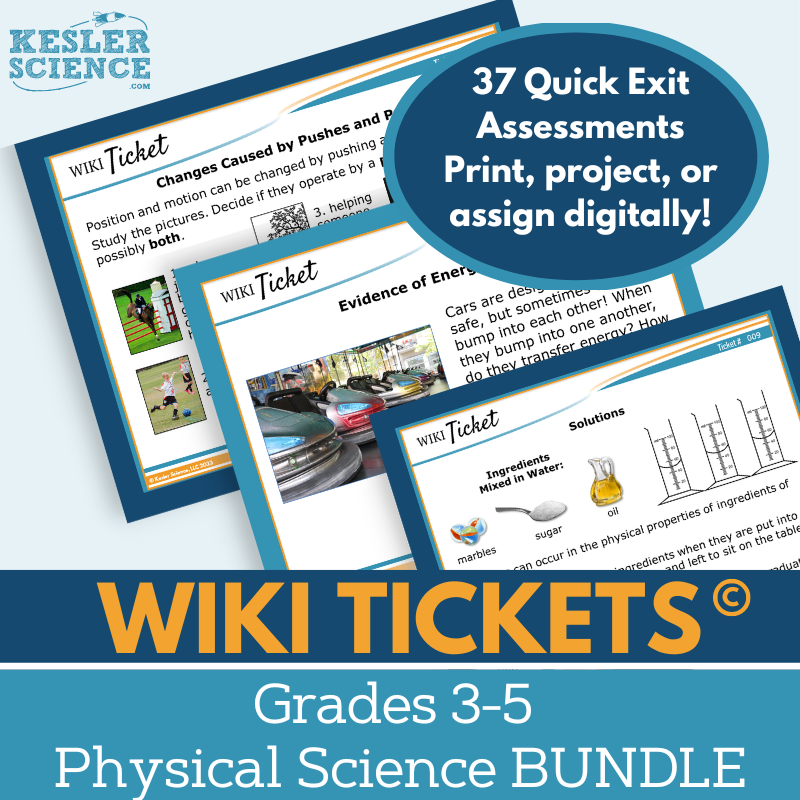Speed & Energy Activities for 4th Grade Science
The Kesler Science Relationship Between Speed and Energy 5E Lesson engages students in exploring the connection between speed and energy through hands-on experiments, readings, research tasks, and interactive activities. The resources below will give students a comprehensive understanding of speed and energy. All of the following materials are also included in the Kesler Science Membership.
The Kesler Science Relationship Between Speed and Energy 5E Lesson explores the relationship between speed and energy through an engaging, student-led approach. This physical science lesson includes presentations, worksheets, choice projects, and assessments, all fully editable and requiring minimal prep. Designed for differentiation, the lesson supports all learners with multimodal activities, including Spanish translations for key materials.
The unit follows the 5E Model, incorporating engagement activities with word wall cards and discussion prompts. Students explore the concept through a differentiated station lab with hands-on experiments, reading passages, research tasks, and videos. They demonstrate understanding through activities such as sorting, writing, illustrating, and assessments. A bonus challenge station offers enrichment opportunities.
The explanation phase features editable PowerPoints and interactive notebook templates in multiple formats. Students elaborate on their learning through choice projects, while the evaluation phase includes updated STAAR-aligned assessments, review questions, and worksheets.
This lesson aligns with NGSS 4-PS3-1 and is flexible for in-class or virtual learning, with digital and printable formats. The comprehensive resources ensure students grasp the connection between speed and energy while allowing teachers to focus on student success.
The Kesler Science Relationship Between Speed and Energy 5E Lesson explores the relationship between speed and energy through an engaging, student-led approach. This physical science lesson includes presentations, worksheets, choice projects, and assessments, all fully editable and requiring minimal prep. Designed for differentiation, the lesson supports all learners with multimodal activities, including Spanish translations for key materials.
The unit follows the 5E Model, incorporating engagement activities with word wall cards and discussion prompts. Students explore the concept through a differentiated station lab with hands-on experiments, reading passages, research tasks, and videos. They demonstrate understanding through activities such as sorting, writing, illustrating, and assessments. A bonus challenge station offers enrichment opportunities.
The explanation phase features editable PowerPoints and interactive notebook templates in multiple formats. Students elaborate on their learning through choice projects, while the evaluation phase includes updated STAAR-aligned assessments, review questions, and worksheets.
This lesson aligns with NGSS 4-PS3-1 and is flexible for in-class or virtual learning, with digital and printable formats. The comprehensive resources ensure students grasp the connection between speed and energy while allowing teachers to focus on student success.
This student-led station lab on the relationship between speed and energy engages 4th-grade students in physical science learning. The lesson allows students to explore how the speed of an object relates to its energy by using evidence to construct explanations.
The station lab consists of eight differentiated activities, plus a bonus challenge station for early finishers. It encourages a student-centered approach, where students work independently or in small groups, with the teacher facilitating learning. The stations include all necessary resources, task cards, and signage for students to complete the activities.
The stations cover various learning modes, including hands-on experiments, reading passages, videos, and research. Students can explore concepts, organize information, illustrate models, write responses, and assess their understanding. The activities cater to different learning styles and include opportunities for both input and output.
This station lab is adaptable for virtual learning, with digital versions of activities available for platforms like PowerPoint or Google Slides, making it a versatile option for in-person or online classrooms.
This student-led station lab on the relationship between speed and energy engages 4th-grade students in physical science learning. The lesson allows students to explore how the speed of an object relates to its energy by using evidence to construct explanations.
The station lab consists of eight differentiated activities, plus a bonus challenge station for early finishers. It encourages a student-centered approach, where students work independently or in small groups, with the teacher facilitating learning. The stations include all necessary resources, task cards, and signage for students to complete the activities.
The stations cover various learning modes, including hands-on experiments, reading passages, videos, and research. Students can explore concepts, organize information, illustrate models, write responses, and assess their understanding. The activities cater to different learning styles and include opportunities for both input and output.
This station lab is adaptable for virtual learning, with digital versions of activities available for platforms like PowerPoint or Google Slides, making it a versatile option for in-person or online classrooms.
The Relationship Between Speed and Energy Student Choice Projects lesson allows 4th-grade students to choose a project that suits their preferred output style. A project page details six student-led options and a "design your own" project, along with an editable grading rubric for teacher, peer, or self-assessment.
These projects offer flexible, multimodal choices, allowing students to creatively demonstrate their understanding. Teachers can adjust the rubric to meet grading needs, and the activities are differentiated, with three modified project options for students needing additional support. For more advanced learners, teachers can combine projects while using the same rubric.
The projects use common classroom supplies like paper, markers, and scissors, and many options are available for digital completion.
The Relationship Between Speed and Energy Student Choice Projects lesson allows 4th-grade students to choose a project that suits their preferred output style. A project page details six student-led options and a "design your own" project, along with an editable grading rubric for teacher, peer, or self-assessment.
These projects offer flexible, multimodal choices, allowing students to creatively demonstrate their understanding. Teachers can adjust the rubric to meet grading needs, and the activities are differentiated, with three modified project options for students needing additional support. For more advanced learners, teachers can combine projects while using the same rubric.
The projects use common classroom supplies like paper, markers, and scissors, and many options are available for digital completion.
The Relationship Between Speed and Energy science writing activity engages 4th grade students in a fun, news event report model to test their physical science knowledge. Aligned with NGSS 4-PS3-1, the activity helps students relate the speed of an object to its energy, extending their science reasoning and writing skills. It is designed for both in-person and virtual learning, allowing flexibility for students to stay engaged inside or outside the classroom.
This resource includes teacher directions, rubrics, projection and print handouts, and a digital version for Google Slides. The writing prompt comes with full-sized handouts, including a pre-writing strategy, and can be printed or used digitally. There are also half-sheet handouts for easy attachment in notebooks or journals. The activity can be used in various ways, such as a cross-curricular exercise, pre-test assessment, student choice project, or extra credit. It supports differentiation and provides opportunities for elaboration for early finishers and make-up work.
This writing activity is ideal for students to apply their prior knowledge while reinforcing the concept of how speed affects energy.
The Relationship Between Speed and Energy science writing activity engages 4th grade students in a fun, news event report model to test their physical science knowledge. Aligned with NGSS 4-PS3-1, the activity helps students relate the speed of an object to its energy, extending their science reasoning and writing skills. It is designed for both in-person and virtual learning, allowing flexibility for students to stay engaged inside or outside the classroom.
This resource includes teacher directions, rubrics, projection and print handouts, and a digital version for Google Slides. The writing prompt comes with full-sized handouts, including a pre-writing strategy, and can be printed or used digitally. There are also half-sheet handouts for easy attachment in notebooks or journals. The activity can be used in various ways, such as a cross-curricular exercise, pre-test assessment, student choice project, or extra credit. It supports differentiation and provides opportunities for elaboration for early finishers and make-up work.
This writing activity is ideal for students to apply their prior knowledge while reinforcing the concept of how speed affects energy.
The WIKI Tickets© Physical Science Set provides engaging, flexible formative assessments for 3rd–5th grade science. This set includes 37 exit tickets, each available in five formats: a full-screen projection version, three printable handouts, and an interactive digital version compatible with PowerPoint and Google Slides.
Aligned with NGSS and TEKS standards, these assessments cover key physical science topics, including forces and motion, energy transformations, evidence of energy transfer, circuits, reflecting light and vision, and uses of energy. Each standard has at least one ticket, and some topics feature multiple assessments. A bonus table of contents file is included to show alignment.
WIKI Tickets© can be used in both in-person and virtual learning settings. Students can respond on printed handouts, their own paper, or digitally in a 1:1 or remote environment. These colorful, engaging assessments work as exit tickets, bellringers, or quick checks to gauge student understanding at any time.
The WIKI Tickets© Physical Science Set provides engaging, flexible formative assessments for 3rd–5th grade science. This set includes 37 exit tickets, each available in five formats: a full-screen projection version, three printable handouts, and an interactive digital version compatible with PowerPoint and Google Slides.
Aligned with NGSS and TEKS standards, these assessments cover key physical science topics, including forces and motion, energy transformations, evidence of energy transfer, circuits, reflecting light and vision, and uses of energy. Each standard has at least one ticket, and some topics feature multiple assessments. A bonus table of contents file is included to show alignment.
WIKI Tickets© can be used in both in-person and virtual learning settings. Students can respond on printed handouts, their own paper, or digitally in a 1:1 or remote environment. These colorful, engaging assessments work as exit tickets, bellringers, or quick checks to gauge student understanding at any time.
Year-Round Resources
These year-round activities will increase your students' understanding of many middle school science topics. All of these activities are also included in the Kesler Science Membership.
Visual Data & Graphing
You're not alone if your students struggle with understanding graphs, charts, and tables. It's a skill that takes an enormous amount of practice. This resource will help students build a strong foundation in analyzing data and creating their own data visualizations.
Bell Ringers and Warm-Ups
These middle school science bell ringers are an excellent way to engage your students as soon as they walk into your classroom. This comprehensive FULL YEAR resource includes everything you need to start off each science class with an interesting warm-up activity.
Review Board Games
Each game board has been carefully designed to keep students engaged. There are 10 different action spaces on each board and dozens of question cards. All of the actions are related to science concepts and keep the students motivated throughout the game.
Each game is ready to play. Simply print out the board and the cards and let the students enjoy reviewing nine different units.
Essential Questions and Standards
Below are the essential questions and standards associated with the lessons and activities included in the speed and energy unit. This topic is only one of more than 100 middle school science topics included in the Kesler Science Membership.
-
What is energy?
-
Describe the relationship between the speed of an object and its energy.
-
NGSS - 4-PS3-1 Speed & Energy
Kesler Science Membership
Imagine never having to search for another middle school science lesson again. The membership gives you access to ALL of the Kesler Science products in one place (Yes, including everything above).
Say goodbye to long hours of lesson prep.











